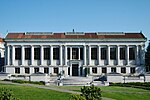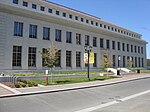California Hall

California Hall is one of the original "classical core" Beaux-Arts-style Classical Revival buildings on the UC Berkeley campus. Construction began in 1903 under the lead of University Architect John Galen Howard after the university's adoption of the Phoebe Hearst master architectural plan for the Berkeley campus. The building opened in August, 1905. In 1982, it was named to the National Register of Historic Places, and is designated as an architectural feature of California Historic Landmark no. 946. In 1991, the Landmarks Preservation Committee of the City of Berkeley designated it Berkeley City Landmark no. 147. It currently houses the University of California Berkeley Chancellor's Office and the Graduate Division.
Excerpt from the Wikipedia article California Hall (License: CC BY-SA 3.0, Authors, Images).California Hall
Sather Road, Berkeley
Geographical coordinates (GPS) Address External links Nearby Places Show on map
Geographical coordinates (GPS)
| Latitude | Longitude |
|---|---|
| N 37.871886 ° | E -122.26037483333 ° |
Address
California Hall
Sather Road
94720 Berkeley
California, United States
Open on Google Maps






